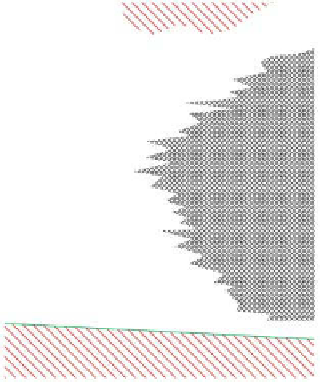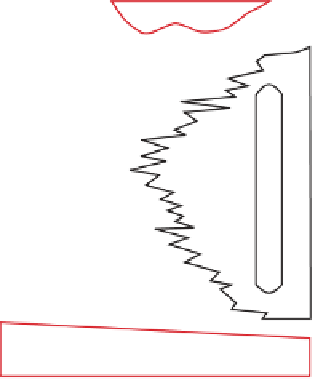Geology Reference
In-Depth Information
Creek are correlated with evaporite cycles 4 and 5
of Peterson & Hite (1969). The Lower and Upper
Ismay are separated by a regional marker bed
on outcrop, the Horn Point Limestone, which is
overlain by a siliceous dolostone that weathers a
characteristic yellow colour and is known locally
as the 'Old Yeller'. The Lower Ismay is correlated
with evaporite cycle 3, and the Upper Ismay with
evaporite cycle 2. The Desert Creek, Lower and
Upper Ismay intervals are characterized by exten-
sive development of phylloid algal buildups in the
subsurface and are important hydrocarbon reser-
voirs in different regions throughout the Paradox
Basin.
PHYLLOID ALGAL MOUND
AND ASSOCIATED FACIES IN
THE PARADOX BASIN
Fig. 2.
General Pennsylvanian stratigraphy of the Paradox
Basin area showing the Desmoinesian age of the stud-
ied Desert Creek and Ismay intervals. Modifi ed from
Goldhammer
et al
. (1991) and Baars & Stevenson (1982).
The following facies descriptions are summarized
from Grammer
et al
. (1996, 2000), and describe
the phylloid algal mound and associated facies
observed both in outcrop and in the subsurface of
the Paradox Basin (Fig. 3). In an attempt to main-
tain some consistency between research projects,
and to facilitate comparisons between different
studies and study areas, we have utilized the same
basic facies terminology fi rst established by Pray
& Wray (1963) and more recently by Goldhammer
et al
. (1991), with minor modifi cation and
augmentation.
The Paradox Formation is defi ned as an evap-
orite facies in the basin centre, but there was
coeval deposition of carbonates and siliciclastics
on the shelf that are included in the formation.
On the shelf, the mixed carbonate-siliciclastic
cycles have been grouped into four major inter-
vals or stages, which in ascending order are the
Barker Creek, Akah, Desert Creek and Ismay
(Fig. 2). The Honaker Trail Formation overlies
these intervals and is composed of cherty lime-
stone and calcareous sandy siltstones in the west.
The Honaker Trail Formation grades into more
massive, arkosic sandstones and gravels toward
the Uncompahgre Uplift in the east. Towards
the end of Pennsylvanian time, the Hermosa sea
withdrew from the Paradox Basin due to regional
tectonics, creating a major unconformity between
the Carboniferous and Permian strata (Grammer
et al
., 1996).
The Desert Creek and Ismay intervals form
the top of the shelfal equivalent of the Paradox
Formation. These shelfal cycles are correlated to
the evaporite cycles in the subsurface through the
use of black shales and dark carbonate mudstones,
which appear to be chronostratigraphic units
(Choquette & Traut, 1963). The cycle-bounding
shales include the Chimney Rock Shale (base of
Desert Creek), the Gothic Shale (base of Lower
Ismay) and the Hovenweep Shale (base of the
Upper Ismay). The carbonate cycles of the Desert
Intermediate facies-diverse biota
The intermediate facies (diverse) is a bioturbated
skeletal wackestone to packstone that, in outcrop,
has thin- to medium-scale undulatory bedding,
rare cross-bedding and a diverse normal marine
fauna consisting of crinoids, brachiopods (atryp-
ids, athyrids, spiriferids, terebratulids and orthids),
tubular and encrusting foraminifera, fusulinids,
molluscs, branching and fenestrate bryozoans,
and minor phylloid algae. Most of the skeletal
grains are broken but not very abraded. This
facies is bioturbated to burrow-mottled indicating
a healthy infaunal element. Much of the matrix
material consists of peloidal mud. The facies con-
tains 5-15% admixed quartz-dominated sand and
coarse silt and 3-5% dolosilt. Bioturbation may
result in a dismicrite fabric with blocky calcite
spar fi lling voids in the matrix mud. Intergranular
blocky calcite spar as well as intragranular cal-
cite spar is common. Some fossil fragments are

















































